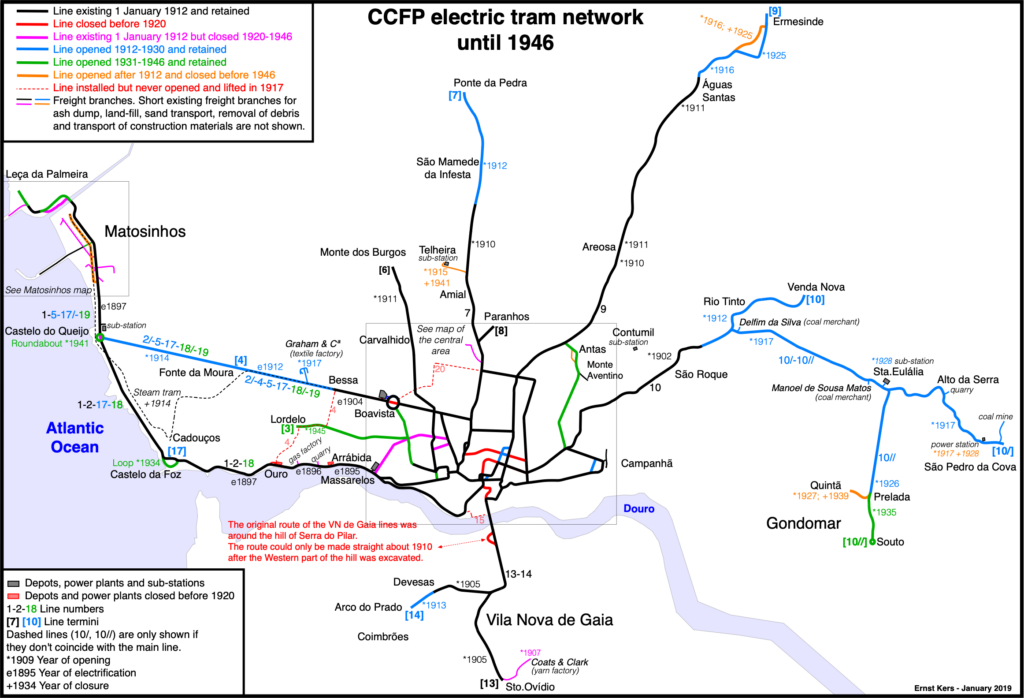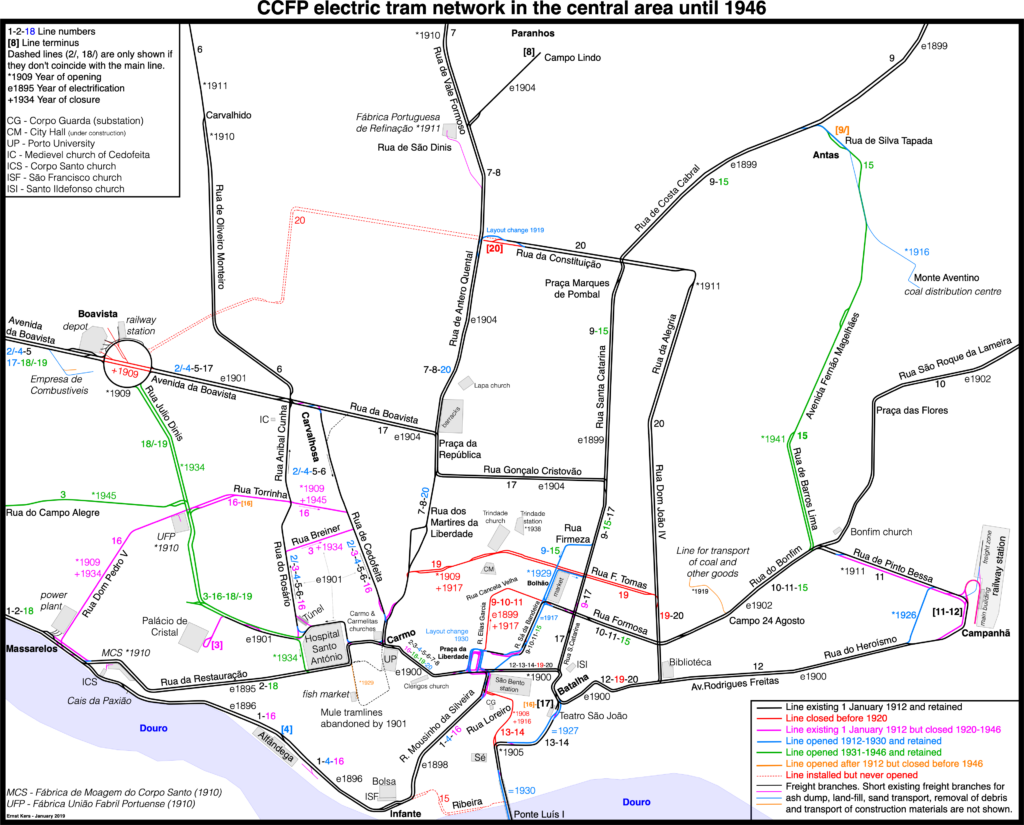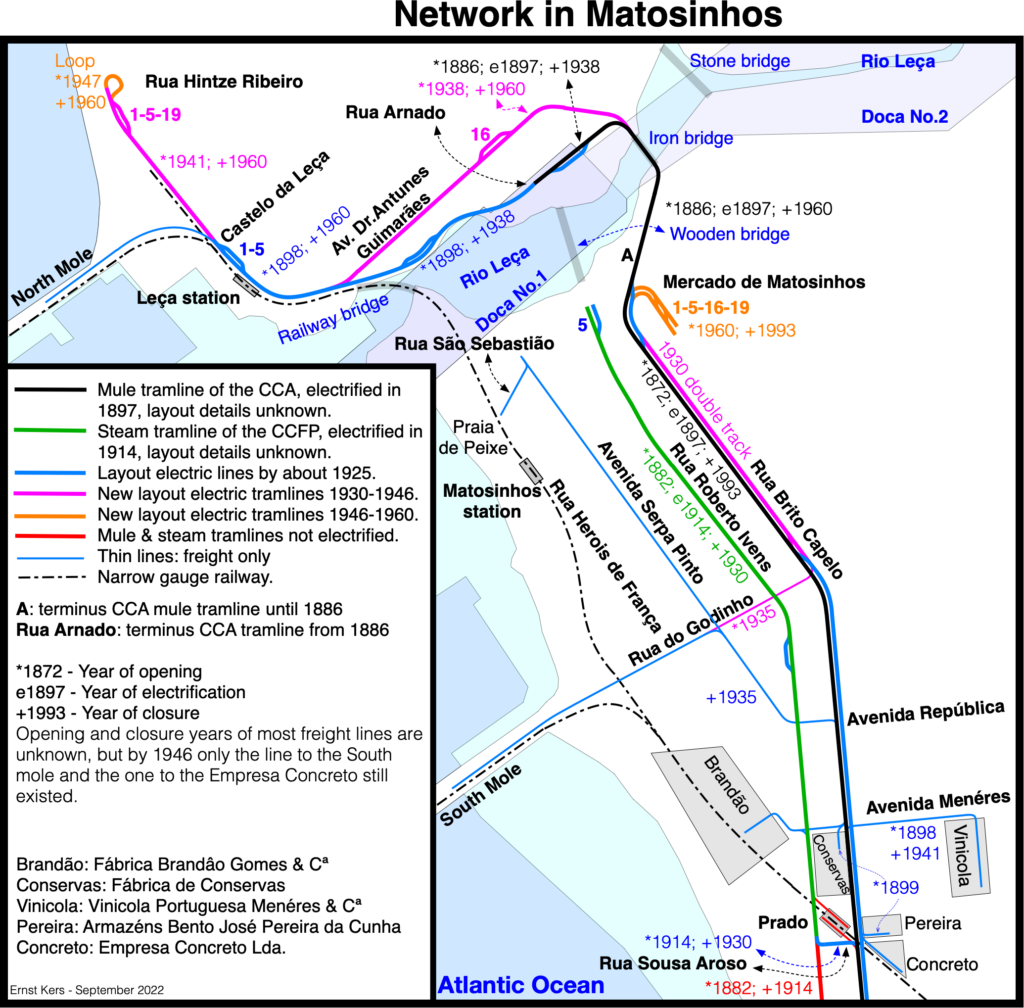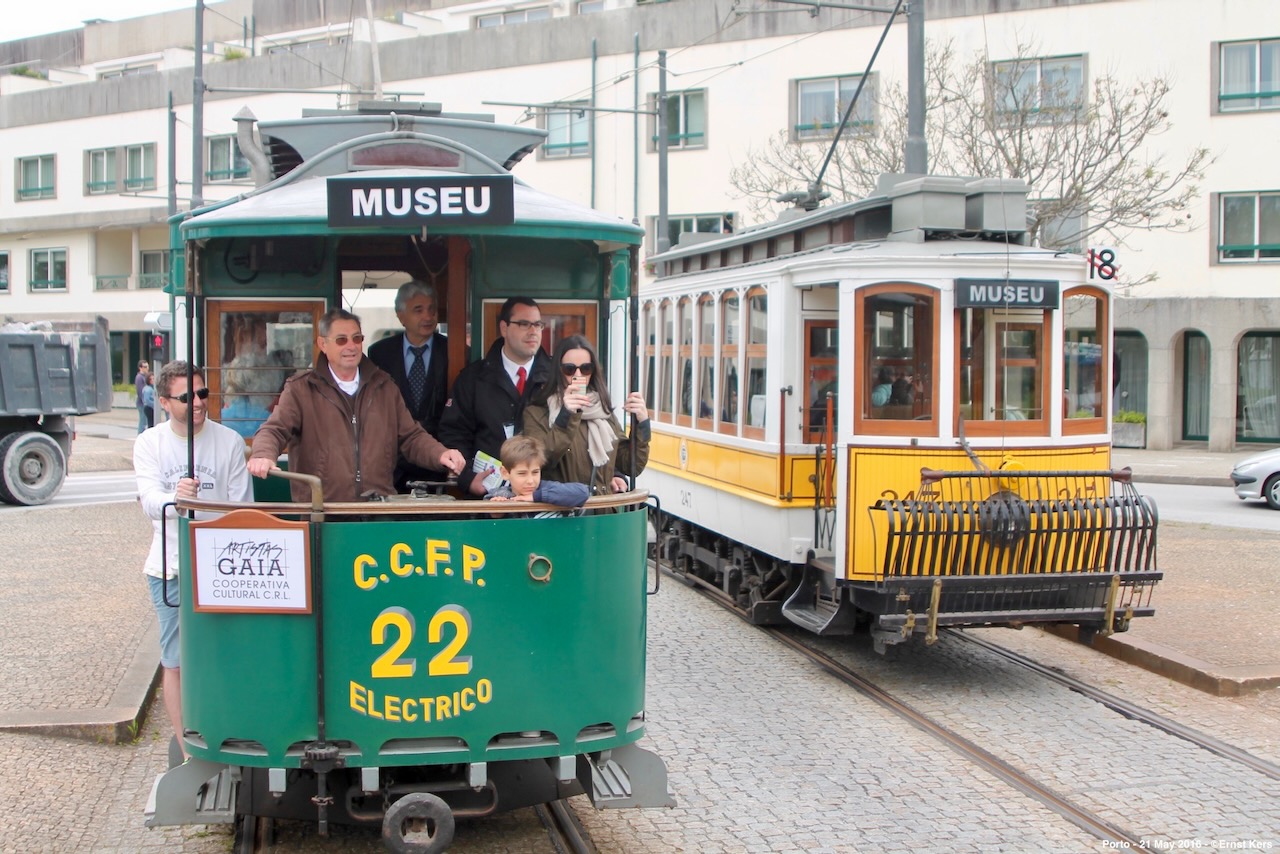The first electric tramline in Porto was opened in 1895. Until 1946 the network was operated by the CCFP: Companhia Carris de Ferro do Porto. This was a private company. In 1946 the operations were taken over by the municipal owned STCP: Serviço de Transportes Colectivos do Porto (now Sociedade de Transportes Colectivos do Porto)
On this page an overview of the network development during the period 1895-1946.
CCFP 1895-1946
Between 1895 and 1904 existing mule tram routes were electrified and until 1911 new electric routes were opened. In this period no line numbers were used as information for the public. The data about the dates electric services started are not always the same, between brackets is probably the date of the official inauguration:
12-9-1895 Campo dos Martyres da Patria – Rua do Ouro (Arrábida)
3-8-1896 (1-8-1896) Rua do Infante D.Henrique – Massarelos and Rua do Ouro (Arrábida) – Estação do Ouro
4-4-1897 (26-3-1897) Ouro – Esplenada da Castelo da Foz (2100 m)
20-7-1897 (29-5-1897) Castelo da Foz – Castelo do Queijo (2300 m)
31-10-1897 Castelo do Queijo – Rua Godinho (1660 m)
28-12-1897 Rua Godinho – Leça (1160 m)
23-4-1898 Praça D.Pedro – Rua do Infante D.Henrique
18-5-1899 (12-5-1899) Praça D.Pedro – Marques de Pombal
13-11-1899 Marques de Pombal – Hospital Conde de Ferreira (Cruz das Regateiras)
6-10-1900 Carmo – Batalha
26-11-1900 Batalha – Campanhã
11-5-1901 Carmo – Praça de Mousinho d’Albuquerque (Boavista)
24-10-1902 Rua St.Catharina – Praça da Corujeira
14-3-1904 Rua da Boavista – Rua C.Cristovão
14-3-1904 Rua F.Thomaz – Duqueza de Bragança
18-8-1904 Carmo – Campo Lindo
18-8-1904 Boavista – Bessa
28-10-1905 Batalha – Ponte Luiz I – Devesas / Santo Ovídio
19-2-1910 Circunvalação – S.Mameda de Infesta
29-5-1910 Cruz das Regateiras – Circunvalação (Areosa)
22-1-1911 Areosa – Águas Santas
Except for passenger trams, there were also freight services.
Until 1911 Praça da Liberdade, until November 1910 Praça Dom Pedro, wasn’t yet the hub of the system as it would become on 1 January 1912. Before that date many trams didn’t terminate on Praça, but continued to another part of the city. Since 1 January 1912 most trams terminated on Praça.
The network introduced on 1 January 1912 allocated line numbers to the services. Of course over the years many changes occurred, but no complete reshuffling from the line numbers.
The individual lines as they existed or were foreseen in 1912 with references to changes that occurred in later years were:
1 Praça da Liberdade – Infante – Massarelos – Ouro – Foz (Castelo) – Castelo do Queijo – Matosinhos (Brito Capelo) – Leça da Palmeira (Castelo).
2 Praça da Liberdade – Carmo – Massarelos – Foz (Castelo) – Castelo do Queijo. In 1915 extended with introducing the line-number 2/ for the new part: Castelo do Queijo – Boavista – Carvalhosa – Carmo – Praça da Liberdade.
In 1934 was in the Palácio de Cristal the Colonial Exposition. This attracted many visitors and a new route between Carmo and Boavista was made via Palácio and Rua Julio Dinis. Since 16 June 1934 the new lines 18+18/ duplicated the lines 2+2/ but went via Palácio instead of Carvalhosa.
3 Praça da Liberdade – Carmo – Jardim do Carregal – Rua do Triumfo (now Manuel II) Palácio de Crystal. Opposite direction Rua do Triumfo – Rosário – Breyner – Cedofeita – Carmo. This line was closed in 1934.
(4) Praça da Liberdade – Carmo – Carvalhosa – Boavista – Lordelo – Ouro. Although the tracks from Boavista to Ouro were installed, line 4 was never opened and the tracks lifted again in 1917.
5 Praça da Liberdade – Carmo – Carvalhosa – Boavista – Fonte da Moura. Extended as successor of the steam tramline with: Fonte da Moura – Castelo do Queijo – Matosinhos (Rua Roberto Ivens / Rua Sto.Amaro). The CCFP wanted double track in Rua Brito Capelo to let both lines 1 and 5 use this street. However until 1929 the CM of Matosinhos did not allow double track in the Northern part of Rua Brito Capelo. Instead the steam tram route in Rua Roberto Ivens north of Rua Sousa Aroso was electrified and used by line 5. On 1 July 1930 line 5 left Rua Roberto Ivens and and joined the route of line 1 to Leça da Palmeira (Castelo), now with double track over the whole length of Rua Brito Capelo.
In 1934 was in the Palácio de Cristal the Colonial Exposition. This attracted many visitors and a new route between Carmo and Boavista was made via Palácio and Rua Julio Dinis. Since 16 June 1934 the new line 19 duplicated line 5 but went via Palácio instead of Carvalhosa.
6 Praça da Liberdade – Carmo – Carvalhosa – Carvalhido – Monte dos Burgos.
7 Praça da Liberdade – Carmo – Praça da República – Rua de Vale Formoso – Amial – São Mamede – Ponte da Pedra.
8 Praça da Liberdade – Carmo – Praça da República – Rua de Vale Formoso – Paranhos (Campo Lindo).
9 Praça da Liberdade – Bolhão – Praça Marquês de Pombal – Rua Costa Cabral – Areosa – Águas Santas. On 8 February 1916 extended to Ermesinde. In January 1925 the line was diverted following a new road passing under the Minho/Douro railway.
10 Praça da Liberdade – Bolhão – Bonfim – São Roque – Venda Nova.
In 1918 line 10A, later indicated as 10/, was opened using the in 1917 opened freight line to São Pedro da Cova branching off line 10 in Rio Tinto:
10/ Praça da Liberdade – Bolhão – Bonfim – São Roque – Santa Eulália – São Pedro da Cova. This route was mainly intended for the transport of coal from the mines and the number of passenger trams was for many years limited, passengers with passes being also carried on the coal cars. In a letter to the mine company of 6 July 1922 the CCFP specified the (number of) passengers allowed to travel on a coal car: two passengers + an employee of the mine + one of the three directors or three engineers of the mine, making a total of four passengers.
On 4 October 1926 the branch line from Santa Eulalia to Gondomar (Bouça Cova / Prelada) was opened:
10// Praça da Liberdade – Bolhão – Bonfim – São Roque – Santa Eulália – Gondomar (Prelada). This branch was extended in Gondomar in 1927 from Prelada to Quintã and on 1 January 1935 from Prelada to Souto. The 400 m long branch Prelada – Quintã was already closed on 1 October 1939.
11 Praça da Liberdade – Bolhão – Bonfim – Campanhã.
12 Praça da Liberdade – Batalha – São Lazaro – Heroismo – Campanhã. For some years around 1913 the lines 11 & 12 were combined as a circular service. The clockwise route had the number 11, the counter clockwise route the number 12. Later both services were made independent from each other again. Around 1930 line 11 was for some time a circular line Praça – Batalha – São Lazaro – Heroismo – Campanhã – Bonfim – Bolhão – Praça in both directions (clockwise 11/) while line 12 was retained. Later line 11 was reduced again to its original route.
13 Praça da Liberdade – Ponte Luiz I (upper deck) – Santo Ovidio.
14 Praça da Liberdade – Ponte Luiz I (upper deck) – Devesas. In 1913 extended to Arco do Prado.
There were two routes between Praça da Liberdade and the Ponte Luís I: via Batalha and since 1908 via the narrow streets Rua Loreiro and Rua Chã. The latter route was suspended again in 1917.
(15) Praça da Liberdade – Infante – Ribeira – Ponte Luiz I (lower deck) – VN de Gaia. Although the tracks and overhead lines from Infante via Ribeira until the lower deck of the Ponte Luiz I were installed, line 15 was never opened and the tracks were lifted again in 1917.
16 Praça da Liberdade – Infante – Massarelos – Rua D.Pedro V – Piedade – Largo de Sá Pinto – Torrinha – Cedofeita (opposite direction Rosário) – Carmo – Praça da Liberdade (circular line in both directions)
In 1934 the route via Rua D.Pedro V was closed and line 16 was changed to:
16 Batalha – Praça da Liberdade – Carmo – Palácio – Rua da Piedade – Largo de Sá Pinto – Torrinha – Cedofeita (opposite direction Rosário) – Carmo – Praça da Liberdade – Batalha. The loop between Carmo and Largo de Sá Pinto was operated in both directions.
On 13 April 1945 the counter clockwise direction was suspended and the whole line 16 was closed about six weeks later on 27 May 1945.
17 Batalha – Bolhão – Gonçalo Cristóvão – Praça da República – Boavista. This was for many years the only line not reaching the hub of the network at Praça da Liberdade. In later years it was extended in stages to Bessa – Fonte da Moura – Castelo do Queijo – Foz and Matosinhos. The trams to Matosinhos carried the number 17/.
18 Praça da Liberdade – Carmo – Carvalhosa – Boavista – Fonte da Moura – Foz (Cadouços) – Castelo do Queijo – Matosinhos (Roberto Ivens). The electric trams of line 18 between Praça da Liberdade and Boavista gave at Boavista connection to the steam tramline which officially also got the number 18. The steam tramline was not electrified together with the mule tramlines except for the section between Boavista and Bessa where the steam trams shared their tracks with an urban electric tramline. On 9 November 1914 the route via Cadouços was closed and the steam tram and its connecting electric tramline were suspended. The line number 18 was since 1934 used again for a new line parallel to line 2.
19 Praça da Liberdade – Carmo – Rua da Conceição – Trindade – Fernando Tomás – São Lazaro – Batalha – Praça da Liberdade (circular line in both directions) Already closed in 1917. The line number 19 was since 1934 used again for a new line parallel to line 5.
20 Praça da Liberdade – Batalha – São Lazaro – Rua Alegria – Rua da Constituição (near Rua Antero Quental). In 1919 extended to: Praça da Republica – Carmo – Praça da Liberdade (circular in both directions)
Line 20 was foreseen as a circular line via Boavista and Carvalhosa. The tracks between Rua da Constituição and Boavista were installed, but not used and lifted again in 1917. Only in 1949 these tracks were installed again and line 20 diverted via Boavista.
In 1912 also three lines were opened which had a character instead of a number as indication:
A Infante – Praça da Liberdade – Praça Marquês de Pombal – Rua Costa Cabral – Areosa
B Bessa – Boavista – Carvalhosa – Carmo – Praça da Liberdade – Batalha – São Lazaro – Heroismo – Campanhã
C Boavista – Carvalhosa – Carmo
The lines A and C were already suspended in November 1914. Line B was changed to
B Bessa – Boavista – Carvalhosa – Carmo – Praça da Liberdade – Infante – Alfândega
Soon the indication B wasn’t used anymore on the trams of this line which didn’t operate during the evening. In July 1927 it became line 4
4 Fonte da Moura – Bessa – Boavista – Carvalhosa – Carmo – Praça da Liberdade – Infante – Alfândega.
About 1940 a supplementary line via Palácio instead of Carvalhosa was opened.
4/ Fonte da Moura – Bessa – Boavista – Palácio – Carmo – Praça da Liberdade – Infante – Alfândega.
Although the services on the existing lines were improved, the CCFP failed to re-install the tracks removed during WWI but were obliged according to the concession. This raised yet another dispute with the CMP which eventually ended in the court where the CCFP lost its case. Most of the old tracks however never returned. Instead the CCFP and the CMP came to an agreement for making more prosperous lines which were not included in the concession.
Opened on 14 December 1941:
15 & 15/ Praça da Liberdade – Bolhão – Bonfim – Antas – Rua Costa Cabral – Praça Marquês de Pombal – Bolhão – Praça da Liberdade; (line 15 counter clockwise, line 15/ clockwise)
Opened on 27 May 1945:
3 Praça da Liberdade – Carmo – Palácio – Lordelo.
CCFP period maps





Leave a Reply